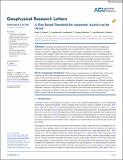A flux‐based threshold for anaerobic activity in the ocean
Author(s)
Zakem, Emily J; Lauderdale, Jonathan; Schlitzer, Reiner; Follows, Michael J
DownloadPublished version (896.4Kb)
Publisher with Creative Commons License
Publisher with Creative Commons License
Creative Commons Attribution
Terms of use
Metadata
Show full item recordAbstract
© 2021. The Authors. Anaerobic microbial activity in the ocean causes losses of bioavailable nitrogen and emission of nitrous oxide to the atmosphere, but its predictability at global scales remains limited. Resource ratio theory suggests that anaerobic activity becomes sustainable when the ratio of oxygen to organic matter supply is below the ratio required by aerobic metabolisms. Here, we demonstrate the relevance of this framework at the global scale using three-dimensional ocean datasets, providing a new interpretation of existing observations. Evaluations of the location and extent of anoxic zones and a diagnostic rate of pelagic nitrogen loss are consistent with previous estimates. However, we demonstrate that a threshold based on substrate-supply fluxes is qualitatively different from a threshold based solely on the ambient oxygen concentration. This implies that use of the flux-based threshold in global biogeochemical models can result in different predictions of anaerobic activity and nitrogen loss.
Date issued
2021Department
Massachusetts Institute of Technology. Department of Earth, Atmospheric, and Planetary SciencesJournal
Geophysical Research Letters
Publisher
American Geophysical Union (AGU)